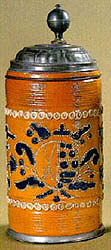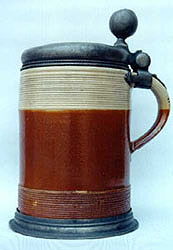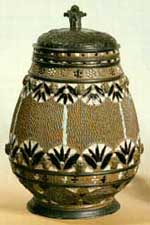Historical Salt-Glazed Stoneware
From Central Germany*
by Uwe Finke
(Reprinted with the permission of the author, who is the archivist and historian responsible for the Rastal Collection of Historical Drinking Vessels, Hohr-Grenzhausen.)
In Thuringia and Saxony, where there are deposits of high quality clay between the rivers Saale and Mulde, as well as further to the east in Lusatia, centers at which the local potters knew how to produce stoneware developed at an early date. They were given the impetus for this by their knowledge of Siegburg ware which was imported into their area in the 15th and 16th centuries. The ceramic ware enjoyed a better reputation than the local earthenware — and also brought a higher price. The potters therefore strove to be able to manufacture such vessels with vitrified bodies themselves.
After tedious experiments, accompanied by an improvement in the kilns (furnaces), this was probably achieved at the end of the 15th century. Technical progress was followed by that of the artistic craftsmen’s designs. The 16th century potters in central Germany quite certainly received their inspiration from Rhenish stoneware in many respects — the application of salt glazing was probably adopted from there — but the further development of central German stoneware was, for the most part, local and independent. The artists’ and craftsmen’s achievements are on a par with those of the Rhenish masters.
It is not possible here, for reasons of space, to go into detail about the development and characteristics of each central German stoneware center. Therefore only the most typical features will be briefly described, followed by illustrations of one vessel from each location as an example.
Waldenburg
 |
| Figure 1 |
The oldest and most important pottery center in central Germany is Waldenburg. This small town on the Zwickauer Mulde had a potters’ guild as early as 1388 (admittedly, no stoneware was yet being manufactured at that time). The heyday of stoneware production was in the period between the second half of the 16th century and the first third of the 17th century. Waldenburg stoneware was much in demand in the entire central and east German area, and it is even said that there were extensive exports to Venice. The salt-glazed bodies were given an oxidizing firing (i.e., oxygen-rich), thus producing the typical brown color. Later, reduction firing (reduced levels of air/oxygen) was also employed, giving a grey body color. Typical vessel forms were elongated, egg-shaped jugs and pitchers, so-called bee-hive tankards (Figure 1) and small casks. The vessels were decorated mainly with cylinder stamp patterns and superbly worked appliques, often with a biblical or heraldic motif. With regards to color, the Waldenburg potters were already using cobalt blue at the close of the 16th century. However, they threw the cobalt glaze at their wares in the kiln, in contrast to the Rhenish potters who painted their vessels with it, using a brush.
Altenburg
 |
| Figure 2 |
The same clay bed as that used by the Waldenburgers was also used by the stoneware potters of the small residence town of Altenburg. Excavations have shown that the first stoneware was probably made here about 1620-1630. If the products initially showed similarities to those from Waldenburg, they soon developed a wealth of forms and decorations of their own. In addition to stocky, broad beer mugs, production was devoted particularly to cylindrical jugs, the decoration of which gave them the name “pearl jugs” (Figure 2). This ornamentation, which first appeared around 1690 and was used through the entire 18th century, was created by applying, by means of a tube, small pearls produced from a white baked (fired) material. Other vessel forms, occurring only in Altenburg, were the spherical and bellied “medallion jugs,” the sides of which were decorated with mounted pewter medals.
Zeitz and Bürgel
 |
| Figure 3 |
The potters of Zeitz and Bürgel in Thuringia were also influenced by Waldenburg. Stoneware was probably manufactured there from the 17th century on. It is not possible to distinguish between the products from the two towns with complete certainty, which is why they are generally dealt with together. In particular, the small appliques adopted from Waldenburg are typical for both towns. The preferred forms of vessels are egg-shaped jugs and pitchers with a spout just below the neck, and partially decorated with round appliques. These vessels, which were fired in a reducing atmosphere, are similar to Westerwald stoneware with their blue coloring. Egg-shaped flasks with handles, decorated with paintings in addition to the blue coloring, are mainly ascribed to Bürgel (Figure 3).
Rochlitz and Luzenau
 |
| Figure 4 |
The towns of Rochlitz and Lunzenau did not quite achieve the importance of the aforementioned potters’ centers.
Although pottery had also had a long tradition there, stoneware was most likely only manufactured there in the 18th century — and probably only in one vessel form. This was a cylindrical stein which, apart from fluted zones beneath the rim and above the bottom, was left completely devoid of decoration (Figure 4). The bodies acquired a yellowish color in the oxidizing firing. As a contrast to this, the fluted zones were frequently colored brown by means of a clay engobe (thin clay slip). This coloring earned these vessels the popular designation of “honey jugs.”
Annaberg
 |
| Figure 5 |
Annaberg, located in the Saxon Erz Mountains, is better known as a mining town (Erz = ore). Strictly speaking, the Annaberg potters’ products are not stoneware, because the clay used by the potters did not vitrify. The vessels were therefore covered with a dark brown vitrifying engobe of “brownstone,” which also allowed salt-glazing. Production of the brown engobe ware began about 1630, and lasted until the second half of the 18th century. Initially, production was mainly of low, broad tankards, screw-top flasks and pitchers with spouts, which were decorated with scroll-work cartouches, scalloped patterns and acanthus friezes. Starting about 1640, the vessels were painted with bright enamel colors which were given a second firing at about 700-800°C. As typical decorative designs on the tankards, as well as on the pear-shaped jugs so especially popular in the second half of the 17th century, we find, in addition to portraits (Figure 5), coats-of-arms and hunting motifs, friezes made up of arcs and finials, applied at the neck and base areas, as well as palmettos and serpentines. The inspiration for enamel painting possibly came from Creussen in Frankonia, whose enamelled jugs and steins were very much in demand.
Freiburg
 |
| Figure 6 |
In the early period of Annaberg production, it was almost impossible to distinguish these vessels from those coming from the town of Freiberg, also in the Erz Mountains, situated to the east of Karl-Marx-Stadt (Chemnitz). It is assumed that stoneware was only manufactured here in the 17th century. Around 1650, the vessels were decorated mainly with chip-carving and stamped ornaments. The sides were adorned with a fine network, interrupted by engraved rosettes, embossed flowers and leaves (Figure 6). Small appliquéd angel and lion heads are also occasionally seen. After 1660 the Freiberg stoneware potters used mainly reducing furnaces. The uniformly grey vessels were, in addition, painted with bright enamel colors, giving them an elegant, distinguished appearance. The favorite vessel forms in the “grey” period were pear- and egg-shaped jugs, as well as short pitchers with spouts.
Muskau
 |
| Figure 7 |
In Lusatia is to be found the most easterly area for the production of salt-glazed stoneware. The pottery tradition of the town of Muskau appears to date back just as far as that of Waldenburg. It would also appear that the technology of vitreous firing was mastered at an early stage — findings indicate the end of the 15th century. As similar stoneware was manufactured in localities to the east of the Neisse River, such as Triebel and Teuplitz (now in Poland), it is not easy to distinguish among the products from the individual towns. The term “Muskau stoneware” is therefore often used for products from the whole of Lusatia (Figure 7). (Lusatia is the area of eastern Germany and southwestern Poland bound by the Lusatian Mountains and the Oder River.)
The prime era of Lusatian pottery was in the 17th and 18th centuries. There was no other center of stoneware production in which such a variety of vessel forms, types of decorations and body coloring occurred as in Lusatia. Furnaces were used with an oxidizing atmosphere to obtain brown coloring, and a reducing atmosphere to obtain grey. In addition, there was at least one pottery where the vessels were covered with a brown engobe. Decorations included appliques, incised networks and drawings, circular ornamentation, and mounted quartz pebbles. One feature common to the majority of vessels, and thus an unmistakable sign of Lusatian origin, is the diagonal and vertical chip-carving on the lower portions of the sides. The most important vessel forms are egg- and pear-shaped jugs, pitchers with spouts, and screw-top flasks with smooth sides, their edges protected by rope-like molding. Grey vessels with incised drawings and cobalt-blue and manganese-purple coloration are similar to Westerwald products. It is still not clear to what extent there were any links between these areas in the second half of the 17th century.
__________
*Reprinted by permission from Prosit, the Journal of Stein Collectors International, Vol 2, No. 1, March 1992
Editor’s Note: Where available, the black and white pictures originally appearing with this article have been replaced with color photographs containing similar subject-matter.
New material ©2000 Beer Stein Library — All rights reserved.








